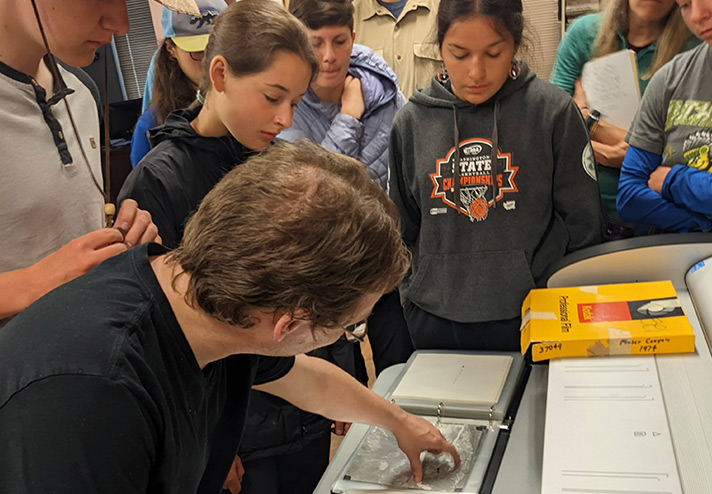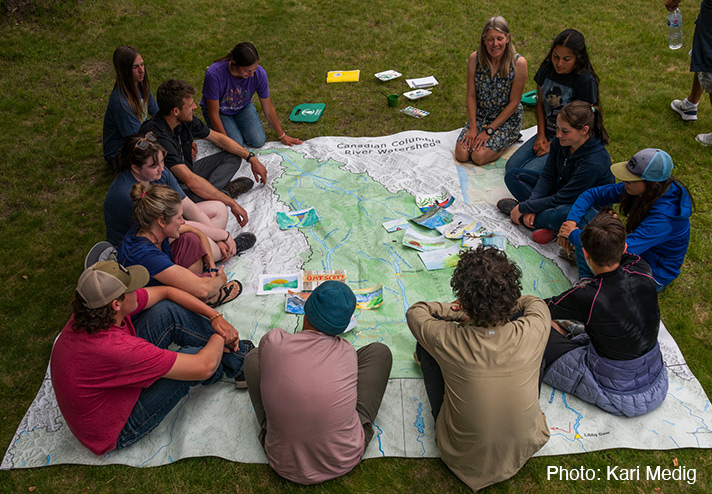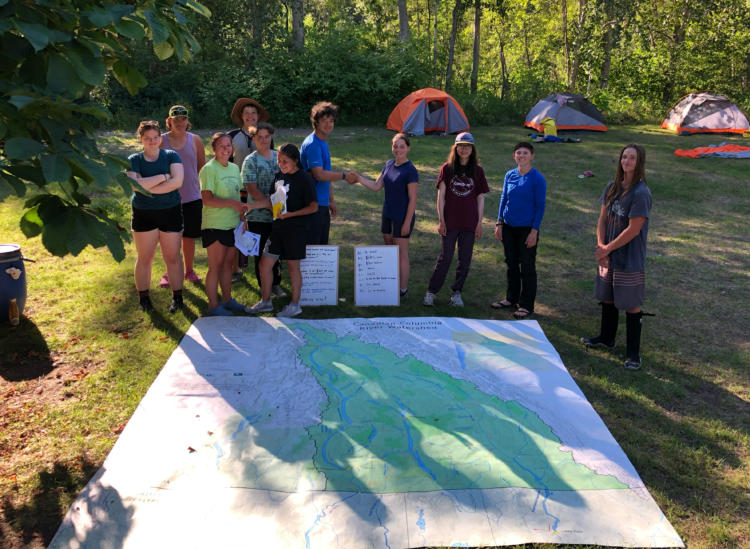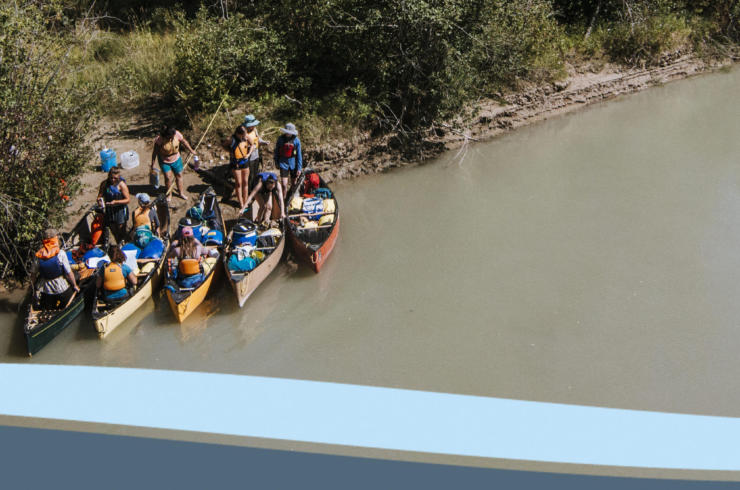Applications close May 22 for this year’s Columbia River Field School: learn more.
—–
You may have heard about the Columbia River Treaty in the news once, or perhaps many times, over the last decade.
The Columbia River Treaty is an agreement between Canada and the United States about our shared watershed. It was originally ratified in 1964 with negotiations to “modernize” it ongoing since May 2018. It’s big. It’s complicated. It’s important. It’s confusing.
It is a topic, and a process, dominated by experts: serious negotiators, busy scientists and computer modellers, wizened elders and knowledge keepers, cautious politicians, impassioned advocates. For people occupied with the other uncountable number of things happening in our public and private lives (almost everyone), a clear understanding of the treaty and what it means for us remains largely inaccessible.
This is also true for young people who become students of Wildsight’s Columbia River Field School. Since 2018, this unique program has guided diverse groups of teenagers (15-18 years old) on annual journeys down the Columbia from its headwaters in Canal Flats to its confluence with the Kootenay River in Castlegar. To date, we have taken youth from twenty different communities across our region on this 15 day learning adventure.


So, what happens if teenagers are made responsible for this crucial matter?
Well, I’ll start by saying that teenagers should not actually renegotiate the Columbia River Treaty. Though students of the field school gain a much deeper understanding of the watershed than most, they are not experts. And the treaty does really deserve expert handling.
In the process of crafting a new treaty over a handful of hours, they inevitably fumble key points and miss important details. To quote one of this year’s students: “Lots of numbers, too many numbers…”
But, what they lack in precision they make up for in their instincts and values. Today’s youth have much to teach us. Their perspectives have not yet been blunted by entrenched realities of the status quo, and this fresh thinking points towards a bright future.
Let me give you a few examples from this year’s mock treaty negotiation:
1. Who is at the decision making table?
The students assigned to play looked across the border and noticed that tribes in the U.S. did not have the same standing as members of their country’s negotiating team. They decided this was unjust and unproductive. So, they recruited their partners on the Canadian negotiating team (the provincial and federal governments) and made a joint request to the U.S. negotiating team to rectify the situation. Under pressure from Canada as well as its own constituents, the U.S. agreed and invited the tribes to become full members on its side.
In real life, I suspect both countries would quickly point out that doing something like this would push the boundaries of national sovereignty. Canada would probably not appreciate the U.S. telling it who should be on its negotiating team and so would probably not weigh in on the decisions of its counterpart.
But these teens are not wrong to push these kinds of boundaries. To paraphrase from the work of leading water scholars such as Dr.’s Barbara Cosens, Emma Norman, and Karen Bakker, transboundary water governance centres on a tension between the sovereign rights of states and their needs and responsibilities to cooperate across boundaries. Traditional (colonial) approaches to transboundary water governance have focused on clear divisions of resources and responsibilities in the interest of protecting national sovereignty. But climate change is making it increasingly difficult to keep everything contained within national borders. And at the same time, there is a growing social movement to treat watersheds as whole systems instead of fragmented puzzles whose pieces are only allowed to connect in limited ways (for a local example, see One River, Ethics Matter). This kind of thinking will be essential for large-scale ambitions such as restoring salmon runs from the ocean through the U.S. and towards the Columbia’s headwaters in Canada.

While today’s governments might baulk at the idea of telling each other who to work with, this instinct from our students is consistent with progressive trends in water resource management. Today’s treaty negotiators sit opposite from each other at linear tables with only one chief negotiator on each side. But the negotiating tables of the future might well be round, with many voices empowered to speak on their own behalf.
2. How to build trust between parties?
As I walk around facilitating the exercise, the main question I ask students is: “Do you trust your negotiating team?” (or, “do you trust your partners on this negotiating team?”). The answer was almost always yes.
Why, when there is so much potential for one party to advance its own interests by minimising another’s?
It’s true that the stakes are much lower in a simulated exercise. But, the main reason that all the teams trusted each other is pretty simple: They actually all spoke openly together about their needs and goals.
Each side’s negotiating team convened both individual and joint meetings with all of their constituents. And, prior to negotiations with the other side, they actually walked their constituents through all their strategies and positions and made revisions based on feedback. Mid-way through live negotiations, the negotiators also called a time-out to check in with constituents about how it was going.
As with the prior example, this is a little bit out of touch with reality given that the Canadian and American negotiating teams keep strategies and positions confidential to protect competitive advantage in negotiating with the other side.
But again, the students are pointing towards a much more progressive philosophy of governance than has prevailed over decades past. In the original Columbia River Treaty, there was virtually no consultation of the public or Indigenous nations on either side of the border, and little compassion or compensation given to those evicted from their homes to make way for the treaty reservoirs. This history has sown a legacy of mistrust that is still deeply rooted in affected communities, though it has mellowed some over the decades as people look towards the future.
In contrast, the U.S. negotiating team has been almost entirely absent from the public eye since even before negotiations began in May 2018. This has left American constituents and stakeholders guessing about what their government representatives may or may not be doing.
To quote another letter from the American organizations referenced above, “Canada’s public outreach has become our best source for insight into the negotiations… We understand [they] are sensitive and confidential… [But] Canada’s program proves it is possible to respect negotiation confidentiality without keeping citizens on the sidelines or in the dark… Canada is gaining negotiating strength and judgement from its serious work at democratic engagement. The Northwest and U.S. would gain from the same.”
With their natural gravitation towards transparency and diplomacy, the students from this year’s Columbia River Field School could make for outstanding public servants.
3. What is the value of a healthy ecosystem?
In reflecting on the mock renegotiation exercise, several students said they were surprised to find the two sides had a common interest in the health of the river. Our simulated negotiating teams bargained hard on the size of financial exchanges related to power production and flood control. But they found easy agreement on ecosystems with a commitment to spend at least 20% of the total economic value of the treaty on ecosystem restoration.
They also agreed to reduce the amount of water storage provided in Canada under the treaty from the current 15.5 million acre-feet to just 12 million acre-feet. This 23% reduction will create flexibility in dam and reservoir operations to pursue various ecosystem restoration measures (for more on how this could work, check out materials produced by the Upper Columbia Basin Environmental Collaborative).
Additionally, the U.S. committed to getting robust salmon runs past its Chief Joseph and Grand Coulee Dams (which currently lack fish passage) and across the Canadian border within 10 years.
We didn’t have time to get into the details of exactly where all this money would come from or how it would be allocated and managed. However, the field school students were well aware that this money wouldn’t appear from thin air but would come from “their own pockets” one way or another. Nonetheless, they did not hesitate to place substantial value on that which has been chronically ignored and undervalued in the real Columbia River Treaty, and by society at large, for centuries. If the actual treaty negotiators can do this, or any of the above, it will be a big step towards a better future.
Wildsight thanks the Arjay R. and Frances F. Miller Foundation, the Columbia Basin Trust, the Province of B.C., the Real Estate Foundation of BC, the Recreational Canoe Association of BC, and School District 8 for making the Columbia River Field School and Teach the Columbia possible.
Graeme Lee Rowlands has followed the Columbia River Treaty closely for over six years and been involved in many projects across the watershed. His writing on the treaty and related issues has appeared in over 50 publications, including leading academic and popular outlets. He has traveled the length of the river several times including once like a salmon from sea-to-source by bicycle and kayak. At Wildsight, he serves as program manager for Columbia River Futures (Columbia River Field School, Teach the Columbia, and new upcoming offerings) and Youth Climate Corps.

Columbia River Field School








